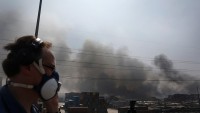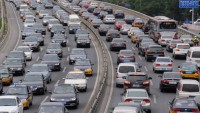China's Pollution Emissions Reduced in First Half of This Year
| Benjie Batanes | | Sep 07, 2015 08:45 AM EDT |
(Photo : REUTERS/Jason Lee) Buildings are pictured on a hazy day in Beijing.
A Chinese government report released on Sunday states that the country's level of pollution has reduced in the first half of this year, compared to the same period in 2014. Beijing credits its current restrictions on the various sources of pollution as the reason why China's air has become cleaner.
Like Us on Facebook
Xinhua reported that the Ministry of Environmental Protection observed that various pollutants such as sulfur dioxide and nitrogen oxide have substantially decrease in the first six month of 2015, compared with the same time period in 2014.
The same report also stated that the government has been treating around 175 million tons of sewage waste a day. Paper manufacturers, printers and other related industries have been ordered to improve their waste treatment and to recycle - if possible.
Many power plants are already using coal that is free of sulfur dioxide. Chinese authorities are also embarking on the construction of power plants that depend on gas instead of coal to further reduce the emission of harmful chemicals.
The various pollution control measures implemented by the Chinese government has paid off. Observers have noticed unusual clear blue skies in Beijing since August 20.
The most harmful of the pollutants, PM2.5, was considerably reduced during the two week period that started on August 20. The reduction was achieved by temporarily stopping firms that contributed the worst pollutants and the odd-even scheme of banning cars from the city streets during certain days
Bejing Municipal Environmental head Zhang Dawei said the two weeks of clear skies and clean air in the capital city is almost similar to those enjoyed by residents in other cities such as Singapore.
During the celebration of the 70th anniversary of the end of the second world war, on September 3, the PM2.5 content in Beijing was at its lowest since 2013 - about 8 micrograms for every cubic meter.
Beijing Research Institute of Environmental Protection assistant director Pan Tao said that the car ban imposed in Beijing was the main factor why PM2.5 was at its lowest. He added that had the government failed to impose the pollution control measures, the pollution of PM2.5 would have been at its highest level instead.
Tagschinese pollution, Beijing Pollution, sulfur dioxide, chinese pollution control, Ministry of Environmental Protection, Beijing Municipal Environmental Protection Bureau, beijing research institute of environmental protection, zhang dawei, pan tao
©2015 Chinatopix All rights reserved. Do not reproduce without permission
EDITOR'S PICKS
-

Did the Trump administration just announce plans for a trade war with ‘hostile’ China and Russia?
-

US Senate passes Taiwan travel bill slammed by China
-

As Yan Sihong’s family grieves, here are other Chinese students who went missing abroad. Some have never been found
-

Beijing blasts Western critics who ‘smear China’ with the term sharp power
-

China Envoy Seeks to Defuse Tensions With U.S. as a Trade War Brews
-

Singapore's Deputy PM Provides Bitcoin Vote of Confidence Amid China's Blanket Bans
-

China warns investors over risks in overseas virtual currency trading
-

Chinese government most trustworthy: survey
-

Kashima Antlers On Course For Back-To-Back Titles
MOST POPULAR
LATEST NEWS
Zhou Yongkang: China's Former Security Chief Sentenced to Life in Prison

China's former Chief of the Ministry of Public Security, Zhou Yongkang, has been given a life sentence after he was found guilty of abusing his office, bribery and deliberately ... Full Article
TRENDING STORY

China Pork Prices Expected to Stabilize As The Supplies Recover

Elephone P9000 Smartphone is now on Sale on Amazon India

There's a Big Chance Cliffhangers Won't Still Be Resolved When Grey's Anatomy Season 13 Returns

Supreme Court Ruled on Samsung vs Apple Dispute for Patent Infringement

Microsoft Surface Pro 5 Rumors and Release Date: What is the Latest?













